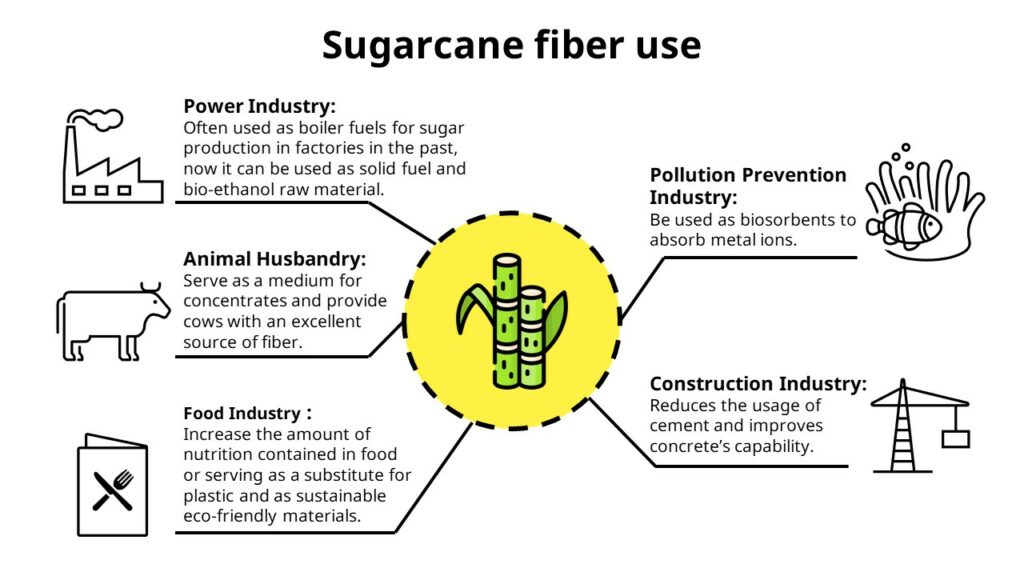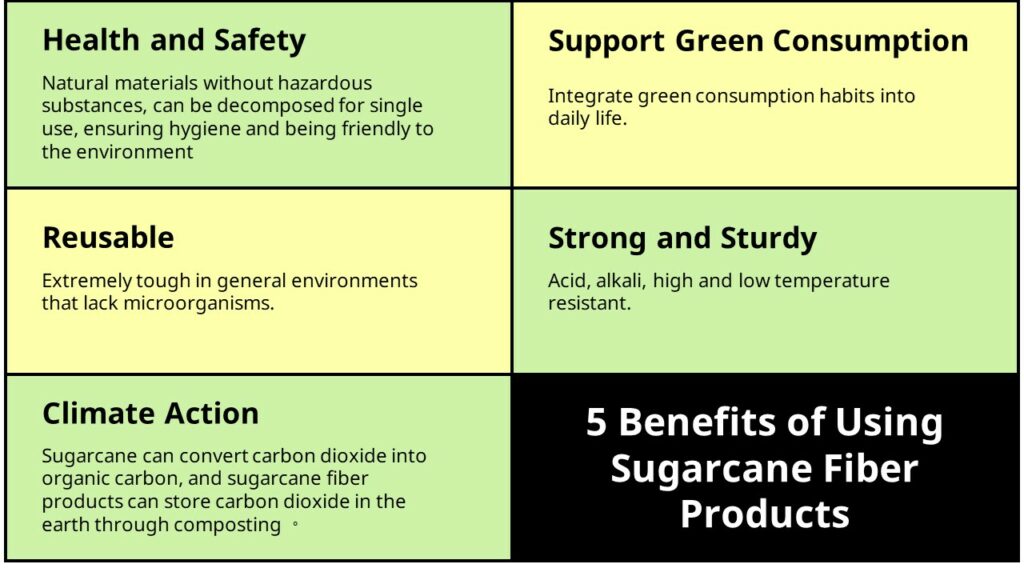
Sugarcane is one of the crops with the largest production volume around the world. Over a billion tonnes of sugarcane are produced annually and thus a large amount of sugarcane fibers is generated. As a result, the use of sugarcane fibers is becoming more and more common day by day. To utilize resources properly, many new applications of sugarcane fibers have been developed. With great potential for development, they can be used as substitute materials for plastic, biofuels, compost or food additives, to name a few.
What is Sugarcane Fiber?
Sugarcane fibers, having high fiber and water content, mainly come from the remains of squeezed sugarcane stems. The history of humans growing sugarcane and producing sugar dates back to ancient Egyptian times. After the Age of Discovery, sugarcane (for which high-temperature and low-humidity environments are best suited) was grown on a large scale in tropical areas as the international sugar trade developed. In modern times, where sustainability increasingly weighs in, sugarcane fibers that remain after sugar extraction are being widely applied in many fields.
How is Sugarcane Fiber Produced?
Sugarcane fibers are made from sugarcane stems. They are what remains after juice and sugar have been extracted. To use them as a substitute for plastic and papers, the remains of sugarcane need to be shredded, cleaned and boiled until sugarcane fiber pulp (similar to paper pulp) is generated. The pulp can be reformed and used for producing various products, including food packaging, papers, textiles and dietary fiber additives.
On February 2021, Volume 169 of the journal “International Journal of Biological Macromolecules” carried an article titled “Cellulosic and hemicellulosic fractions of sugarcane bagasse: Potential, challenges and future perspective”. According to the article’s introduction, the composition of sugarcane fibers are as follows:
- 32% to 45% cellulose
- 20% to 32% hemicellulose
- 17% to 32% lignin
- 1% to 9% ash (minerals and inorganic salts in a plant body)
- Other components
What is Sugarcane Fiber Used for? What are Sugarcane Fiber Products?

Sugarcane fibers are currently being widely applied in many fields related to daily life, such as industry, animal husbandry, agriculture as well as food, pollution prevention and construction. We will introduce these industries one by one regarding their current applications and development below.
Power Industry
Containing a large amount of organic carbon, sugarcane fibers were often used as boiler fuels for sugar production in factories in the past. They were used for generating steam-electric power at the same time. Today, plastic, papers, textiles and other waste can be added and mixed with sugarcane fibers at different heating values. After compression, these will become solid fuels with higher combustion efficiency and lower carbon emissions, and can be used in solid fuel power plants or cement factories.
In addition, the structure of sugarcane fibers can be destroyed by physical or chemical methods. Afterwards, the cellulose and hemicellulose can be hydrolyzed into monosaccharides and fermented with yeasts to produce bio-ethanol for alternative fuel vehicles and power generation.
Animal Husbandry
After sugar extraction, the remaining sugarcane fibers contain low nutritional value. Thus, they cannot be directly used as the main materials of feeds. However, they may serve as a medium for concentrates (or concentrated nutrients, including protein, minerals and thermal energy) and provide cows with an excellent source of fiber.
Food Industry
When lignin in sugarcane fibers is removed after processing, rich dietary fibers will remain with sugarcane fibers. They can be added to foods such as bread and noodles to increase the amount of nutrition contained in food as we as improving the taste.
Bagasse fibers are excellent in toughness. They can be made into bagasse food packaging products such as cups, plates, bowls, straws, and tableware after being reshaped and machined, serving as a substitute for plastic and as sustainable eco-friendly materials.
Pollution Prevention Industry
Unprocessed sugarcane fibers can immediately be used as biosorbents to absorb metal ions including nickel, cadmium and iron. The bioabsorption efficiency can be further improved if the fibers are processed by physical methods (e.g. cutting, grinding and high-temperature sterilization) or if they are chemically modified with organic solvents and surfactants. This helps reduce the pollution caused by the use of chemical substances or dyes in the paper and textile industries.
Construction Industry
Cement is the most commonly used building material around the globe. During its production, a large amount of carbon dioxide along with noxious gases, including hydrocarbon, sulfur dioxide and heavy metals, are emitted. Sugarcane fibers can substitute for some cement and be added to concrete after burning, sieving and grinding. This not only reduces the usage of cement, but even improves concrete’s capability with respect to acid and alkali resistance as well as compression, tensile and flexural strength.
How Sugarcane Fiber is Used in Food Packaging and Cutlery?
Sugarcane fibers are natural materials for manufacturing safe and hygienic food packaging and tableware without the concern for heavy metal, bisphenol A (BPA) and plastic particle dissolution. Not only are such packaging and tableware water- and oil-proof, but they can also withstand a certain degree of pH and temperature change. They are biodegradable and after use can be composted according to the suppliers’ design, which benefits the environment.
The Benefits of Sugarcane Fiber for Environmental
Biodegradable & Compostable
Cellulose is the major component of sugarcane fiber. It can be decomposed by microorganisms in natural environments without producing plastic particles and polluting the environment like plastic does.
Biological Carbon Sequestration
Sugarcane transfers carbon dioxide into organic carbon and stores it in sugarcane fiber in their growing process. After the life cycle of a sugarcane fiber product ends, mixing it into compost for decomposition is helpful to store the carbon in the soil to reduce concentration of carbon dioxide in the atmosphere.
Nutritious Fertilizer
Sugarcane fibers contain rich carbon and can be used for composting after fermentation to provide plants with nutrients and return organic matters to the Earth.
Low-Carbon Alternative Materials
As plant-based materials, sugarcane fibers can substitute for petrochemicals and plastics. Plastics are non-renewable in terms of raw materials. Furthermore, they release the carbon in the crust and return it to the atmosphere in the form of greenhouse gases, resulting in climate change. In addition, sugarcanes consume carbon dioxide in their growing process, making the overall carbon emission of materials basically zero. They are thus suitable as low-carbon alternative materials.
Circular Economy
The Ellen MacArthur Foundation believes that a circular economy should start with redesign. The principles include “eliminate waste and pollution”, “circulate products and materials (at their highest value)” and “regenerate nature.” When conducting commercial activities, try to redesign with sugarcane fibers. This can help reduce waste and pollution caused by agro-processing industries and maximize the use of by-product resources. Meanwhile, they can be continuously recycled and renewed through composting and crop growing to achieve circular economy.
Why Sugarcane Fiber Products? 5 Benefits of Using Sugarcane Fiber Products

Health and Safety
Sugarcane fibers are natural materials without hazardous substances that are frequently applied in plastic or paper products. Plasticizers such as per- and polyfluoroalkyl substances (PFAS), commonly used to make water- and oil-proof or anti-stick products, have sustainability and toxicity, and can be accumulated in the environment, creating potential risks to the health of organisms and human body), and bleaches. Sugarcane fibers are very safe for use as a result.
Though the reuse of products is being promoted at present, disposable tableware needs to be used in some places to ensure hygiene in the modern era where COVID-19 rampages. Bagasse products are appropriate substitutes for disposable tableware, ensuring hygiene without harming the environment.
Support Green Consumption
Green consumption, an eco-friendly consumption pattern, aims to let consumers prioritize eco-friendly products that have lower impact on the environment. Sugarcane fiber products can be naturally decomposed after use and minimize the impact on the environment. Hence, choosing sugarcane fiber products fits perfectly in green consumption.
Reusable
Though sugarcane fiber products can be naturally decomposed, they are extremely tough in general environments that lack microorganisms. Some suppliers such as renouvo specifically intensify the materials and test the products with dishwashers to confirm their reusability. Depending on the situation of use, consumers may decide whether to dispose of the bagasse products to maintain hygiene or to reuse them and make the best of them.
Strong and Sturdy
Bagasse products have the toughness of plants and are acid, alkali, high and low temperature resistant after reshaping. If they are used as food containers, they can contain food in daily catering as well as being reused for several months to years. Compared with products made of paper or others, bagasse products are studier and more durable.
Climate Action
Sugarcane is a C4 crop, a plant that is highly effective in transforming carbon dioxide to organic carbon. In addition, the extremely high demand for sugar facilitates the marvel of sugarcane yields. This means that carbon dioxide can be stored if the opportunities of growing sugarcane are seized, and sugarcane fibers are made into products that can return to the Earth after use instead of being burned. This is a natural way of carbon capture that supports climate action.
Summary
Multifunctional, sugarcane fibers can be made into products and used as substitutes for plastic. They have multiple advantages such as being hygienic, safe, durable and eco-friendly. Moreover, climate actions can be taken to mitigate climate change, the largest crisis that people face at present, during the process of using sugarcane fiber products. Hence, the use of sugarcane fiber products will become a trend in the future.